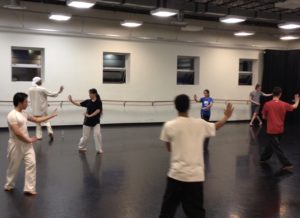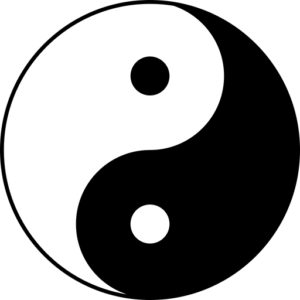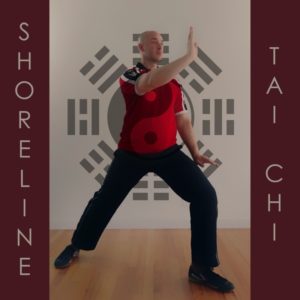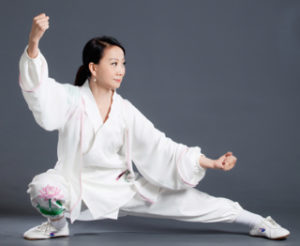Slanted FlyingJournal of Tai Chi Chuan
Training
Taijiquan – Moving Through Molasses
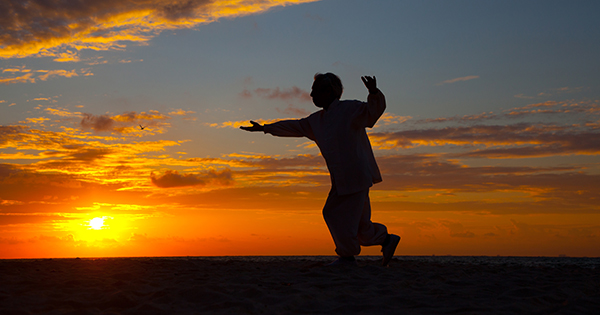
This is consistent with emphasizing softness first, in order to not use the external muscles before the stabilizing muscles have engaged. Developing the external muscles too soon can weaken the stabilizing muscles by taking over, or inhibiting, some of their function. This is, in part, why fangsong (放松 relaxed) is emphasized in Taijiquan training, although we still want to maintain our tonus and elasticity and we want to maintain pengjin (掤 ward off or rebounding energy, the energy of a properly inflated rubber ball).
Having and using strong stabilizing muscles while relaxing the flexors and extensors (mobilizing muscles) would fit with the philosophy of “steel wrapped in cotton” (钢包棉花 gang bao mianhua).
We seek to avoid resisting with the mobilizing muscles while avoiding collapsing or being weak (松懈 songxie, relaxed or slack, complacent). We want to have wiry strength, being slender yet strong and sinewy, like a farm worker rather than muscular like a bodybuilder.
We want to build the strength from the inside stabilizer muscles before using the external mobilizing muscles for applying attacks. We want to defend against attacks by having the strong and resilient structure provided by the stabilizing muscles, and then use fast-twitch muscles to issue attacks and for fajin (發勁 emitting trained power).
We want to develop a unified body that is stable in all directions. Individual mobilizing muscles are best used for expressing energy in one direction, but the stabilizing muscles unify and stabilize the structure as a whole. Some practitioners use the term “bone strength” (vs. muscles) to describe the structure that produces the force that we are looking for in Taijiquan.
Based on what I wrote above, Professor Jonathan Micancin, Ph.D, (personal communication) stated that the muscular-skeletal system works to both support us against gravity and to move us, often using great force, all without wasting energy (by maximizing stillness) or needlessly damaging cells or tissues. There is actually much more than simply differentiating which muscle type is being conditioned when practicing as if moving through molasses.
Although I am unable to explain in detail, the following information from Micancin will give some idea of what is involved.
Moving through molasses trains motor units within the antagonistic muscle groups to work efficiently, as well as the behaviors of various brain regions, and cells of the peripheral nervous system. These changes may be more important than the physical training of the muscular cells and tissues.
There is a hierarchical organization of various components that include the proprioceptors and mechanoreceptors, the somatosensory cortex, the motor cortex, motor neurons, contractile tissues wrapped in connective tissues that distribute the contractile force to tendons across joints, etc.
Moving through molasses trains motor units (groups of skeletal muscle fibers and their motor neurons), within the muscles, to work efficiently together or independently. The isotonic or isometric contraction promotes motor and neurosensory tone, and allows short and fast changes in shape producing more force when more motor units are recruited.
“Short version: moving through molasses allows for more sensitive, faster, stronger, more sophisticated movements in each direction because the sense of touch, the brain, the motor neurons, and the muscles and their constituent motor units are all primed to do so as efficiently as possible” (Professor Micancin).
Our neurology seems to have wired our bodies to have the hands lead our actions, rather than our torso. This is why people often need to be reminded to use their legs when picking up a heavy object. If an object is light, then it doesn’t matter if the hand reaches for it without using the whole body. For example, this is what you see with golfers when they bend to pick up a ball.
But martial artists want a unified structure that can express whole-body power. In Taijiquan, this idea is reflected in the saying that power is generated in the feet, developed in the legs, controlled or directed by the waist, and only expressed in the hands. We want the waist to control our actions, not our hands. We want to use this unified structure regardless of whether the force is heavy or light.
There are several other possible training methods that may produce similar results to moving through molasses.
One would be to hold stationary form postures (zhan zhuang), and have someone assist you by applying pressure to various places on your body, from various directions. While the intended direction for the posture application should be strong, the opposite direction should still feel stable and comfortable. Pressure applied at an angle to the primary direction should also feel stable and comfortable, without having to change the posture significantly (slight, internal changes would be natural, but you would not want to have to make large and visible adjustments, especially if they weaken the primary direction of the posture).
Another option would be to practice push-hands (推手 tui shou) very slowly, initially with light pressure, but later with gradually increased pressure once the practitioners are comfortable with each pressure increment. Here you would want to be as soft as possible (relaxing the flexors and extensors) without having one’s structure collapse (having strong stabilizing muscles).
Since the arms tend to be major culprits for resisting by using force, practitioners could also practice push-hands without using their arms and allowing their training partners to push directly on the torso. This will help ensure that the responses are being done with the torso (our core, ideally our lower dantian, 丹田 elixir field, or the lower abdomen, the area centered in the waist) and legs rather than with the arms (the periphery).
If one does not have a partner to aid in their training, then one can still practice solo forms as if moving through molasses. This practice gives every part of one’s body purpose and intent, as well as stimulating the movement of energy.



